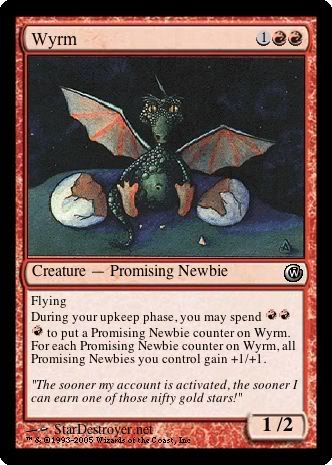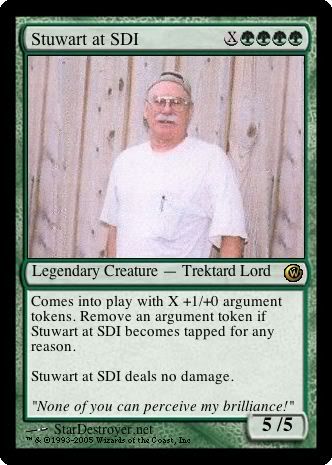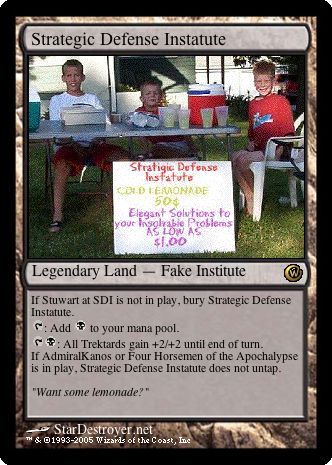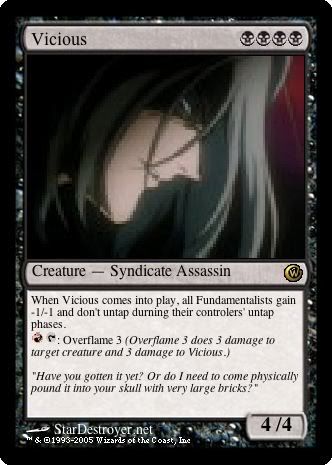Crossroads Inc. wrote:Chris OFarrell wrote:Bloody hell what does all this mean? Tap? Untap? Lands? Ahhhh!
I've seen MTG played a few times, but I never have a clue how it all works.
Dude, didn't someone post a link to the complete rules of MTG a while back for all to read?
Yes, that would have been me. I'll post them again:
Linka.
spongyblue wrote:Ditto on not knowing piddly poo on MTG, but these cards are pretty damn funny.
Goddamn it all, if this keeps happening, I'll start copy-pasting the rules on the thread. Oh, what the hell....
***
QUICK EXPLANATION OF MtG ***
The players represent Planeswalkers, super-powerful magicians with godlike power who are battling for dominance. Their arena are the myriad planes of the MtG multiverse.
Each player has a deck of cards consisting of Lands and Spells. No more than four copies of any given card may be in a given deck, though you may have any number of Basic Lands. Any card that is not a land card is a spell card.
Basic Lands come in five types: Plains, Islands, Swamps, Mountains and Forests. These produce Mana, the energy by which planeswalkers cast their spells. Nonbasic lands can also produce mana, and usually have other abilities besides. Mana comes in five colours: red (produced by mountains, usually associated with Chaos and destruction), green (produced by forests, usually associated with Nature and pointy eared types), white (produced by plains, usually associated with Life and healing, paladins and suchlike), blue (produced by islands, usually associated with Learning and wizardry) and black (produced by swamps, associated with Death, the undead, demons and other nastiness). The casting cost of a spell is indicated in the top right hand corner of a spell card. A circle with a number in it means the indicated amount of mana of any colour must be used. An X means you decide how much you want to spend, this will affect the power of the spell.
***
CARDS ***
Each card has a Name (top of the card), Type (shown below the picture), Mana Cost (top right; Lands never have a mana cost),, Power/Toughness (not all cards have this, only creatures: it represents how much damage the creature can dish out/ how much it can take), Text Box (The stuff in itaics is flavour text, has no effect on gamaplay. Non italics are the rulsey bits).
Also: picture, expansion symbol (to the right in the type line), collector number and legal info and artist's name (bottom), these have no effect on gameplay.
***
BASIC CONCEPTS ***
Tapping: You "tap" a card by rotating it 90 degrees to the right; this indicates that you are using one of its special abilities. Obviously, a card that has been tapped cannot be tapped again, until it is UNtapped. Basically, this is a bookkeeping method to keep track of card usage.
Colour: All spells (NOT lands) have colour, this generally means the colour of the mana that MUST used to cast it, and also appears in the colour of the card background. Artefacts are colourless, they can be cast with any colour (usually a silver background - or brown background for the classic layout). Other spells are multicoloured, they have more than one colour (usually a gold background).
Life: Each player begins with 20 life points. You win the game when you reduce the opponent to 0 life.
Poison Counters: Alter you place 10 poison counters on an enemy player you win the game. This is an alternative win criteria (that is rather less common).
Library: this is your draw deck that is shuffled and face down in front of you during the game. Incidentally you also lose the game if you are called upon to draw a card but cannot, such as if your Library is exhausted.
Graveyard: your discard pile. Certain effects allow you to retreive cards from the graveyard.
Phase out zone: cards that are phased out go here. They don't really do very much in this state, nor can very much of anything be done to them. They are neither tapped or untapped, but "remember" their previous state. A card that is phased out phases in again during the next turn.
The Stack: Spells that are played go in the stack. Priority then alternates between players as they place spells on the stack to redirect/dispel or otherwise foil the previous spell. You may pass here. If two players pass in a row, the stack is resolved.
Pass: Duh.
Permanent: Lands, Creatures, Enchantments and Artefacts are "permanents", i.e. they last longer than the round in which they are played. I.e. they go into the "in play" zone rather than the graveyard once resolved.
In Play: Permanents go here (if they survive the Stack). These are the cards that represent resources that are under your control at any given time. You can only tap cards if they are in play. "leaves play" and "enters play" refers to this zone.
Creature: these are Summoning spells as they are being cast, once they go into the In Play zone, they become Creature cards with a power and toughness score.
Legendary: Only one each of a Legendary creature may be in play at any given time (though you may have four cards of this type in your Library). So if A and B are both legendary creatures, there may only be one A and one B in play, counting the In Play zones of both players.
Artefacts: magical artefacts. Some artefacts such as Golems are also creatures and are referred to as "artefact creatures".
Enchantment: Long-life magic spells or resources. These can only be cast in your main phase when the stack is empty. They can target specific permanents such as creatures "creature enchantments" lands "land enchantments" and even other enchantments "enchantment enchantments". Enchant World spells are such that only one is active at any time. They go into the "in play" zone when cast.
Sorcery: These can only be cast during your own main phase, they go into the graveyard once resolved.
Instant: These can be cast any time you have priority even during an opponent's turn. They go into the graveyard.
The Hand: The cards that you have in your hand. The handsize is seven cards.
Removed from game: what it says. There are worse places to be than the graveyard, you see. Note that "removed from play" does NOT mean the same thins as "removed from the game" though any card that is "removed from the game" is obviously also "removed from play".
Target: you specify what you are affecting with the spell or ability: "this card deals 2 damage to target creature". The target must be legal in the sense that either the card type or the Type Line must match the qualifier of the spell or ability in question. IMPORTANT NOTE: If a card says "destroy all <whatever>", this is NOT a targeting, so if the card cannot be the target of such-and-such a spell or ability, this will not help it in this case: it is a global area-effect kind of thing, not an actual targeting per se.
Golden Rule: if the rule on a card contradicts the rules, the card takes prescedence.
Ante: no longer really used, and forbidden during official tournaments due to legal reasons. A way of playing "for keeps", the top card of the library from each player's deck at the begining of the game.
Activated Ability: You pay mana or tap a card when you want to use one of these.
Triggered Ability: "If <such and such> then <ability>. Nuff said.
Static Ability: One that is always on. Such as "All Mess Members gain +2/+2".
Replacement Effects: replace an instance of a keyword with another. Such as "All blue creatures" becomes "all green creatures" for instance.
Other Effects: Prevention Effects, One-Shot Effects, Continious Effects: I'll let you figure these out on your own.
Tokens: Little thingamabobs you use to represent things that can be tapped. Such as "token creatures". These are destroyed if they phase out.
Counters: Little thingamabobs you use to keep track of Life, Mana and other stuff (such as +X/+Y counters you add to creatures to modify their Power and Toughness). The difference between a "token" and a "counter" is that counters cannot be tapped.
***
GAMEPLAY ***
1) BEGINNING PHASE
a) Untap Step: untap all your cards
b) Upkeep Step: certain cards have an upkeep cost. If you can't pay these, something has to go to the graveyard.
c) Draw Step: Draw a card from the Library. If you can't you lose the game.
2) MAIN PHASE, PART THE FIRSTE
Play any kind of spells and abilities. Your opponent may play activated abilities and instants. Note that your opponent's continious abilities are still in effect though. You may also play ONE land. BTW: You "play" a card from your hand, obviously (not your graveyard or anything - except with funky special abilities or something).
3) COMBAT
a) Players play instants that will affect the combat.
b) You declare attackers. You must tap any creature that is to attack. Once this is done, players may play further instants or activated abilities.
c) Your opponent declares blockers. Tapped creatures cannot block. Each creature may normally only block ONE other creature. And yes, players may play further instants or activated abilities here too once blockers have been declared.
d) Resolve damage. Unblocked attackers deal damage equal to their power to the defending player. Blockers and blocked creatures deal damage to each other, damage is resolved simultaneously (barring funky special abilities like
First Strike). Blocked creatures deal NO FURTHER DAMAGE to the defending player, even if the blocker is destroyed (except if it has a funky ability like
Trample). Note that certain creatures cannot be blocked except under special circumstances, notably creatures with
Flying can only be blocked by other creatures with Flying (unless otherwise noted), and creatures with
Shadow may only block or be blocked by creatures with Shadow (unless otherwise noted).
e) Play any further instants if you really want to.
4) MAIN PHASE, PART THE SECONDE
As Part the Firste. Note: only one land may be played in a given turn.
5) CLEANUP
a) End of Turn Step: More instants and activated abilities. Aren't they fun?
b) Cleanup: Discard from your hand if you have more than 7 cards in your hand. Damage to creatures is removed. All "until end of turn"effects end. You may NOT play instants and activated abilities without a triggered ability that allows it.
***
SOME MORE CONCEPTS ***
Summoning Sickness: You cannot tap a creature on the turn it comes into play. Hence it cannot attack either (it can block, though).
Haste: Special creature ability. Immunity to summoning sickness.
Protection: Creatures or players with Protection from such and such have all damage reduced to zero from such sources. Usually this takes the form of "Protection from <colour>", but could be Artefacts or a creature type for example.
Tapping Lands for Mana: An activated ability as is all tapping. I.e. may be used during your opponent's turn. You tap the land and add the mana to your mana pool.
Mana Pool: The mana you have produced and are able to use to cast spells.
Mana Burn: Loose one life per mana in your mana pool at the end of each phase. That mana is wasted.













